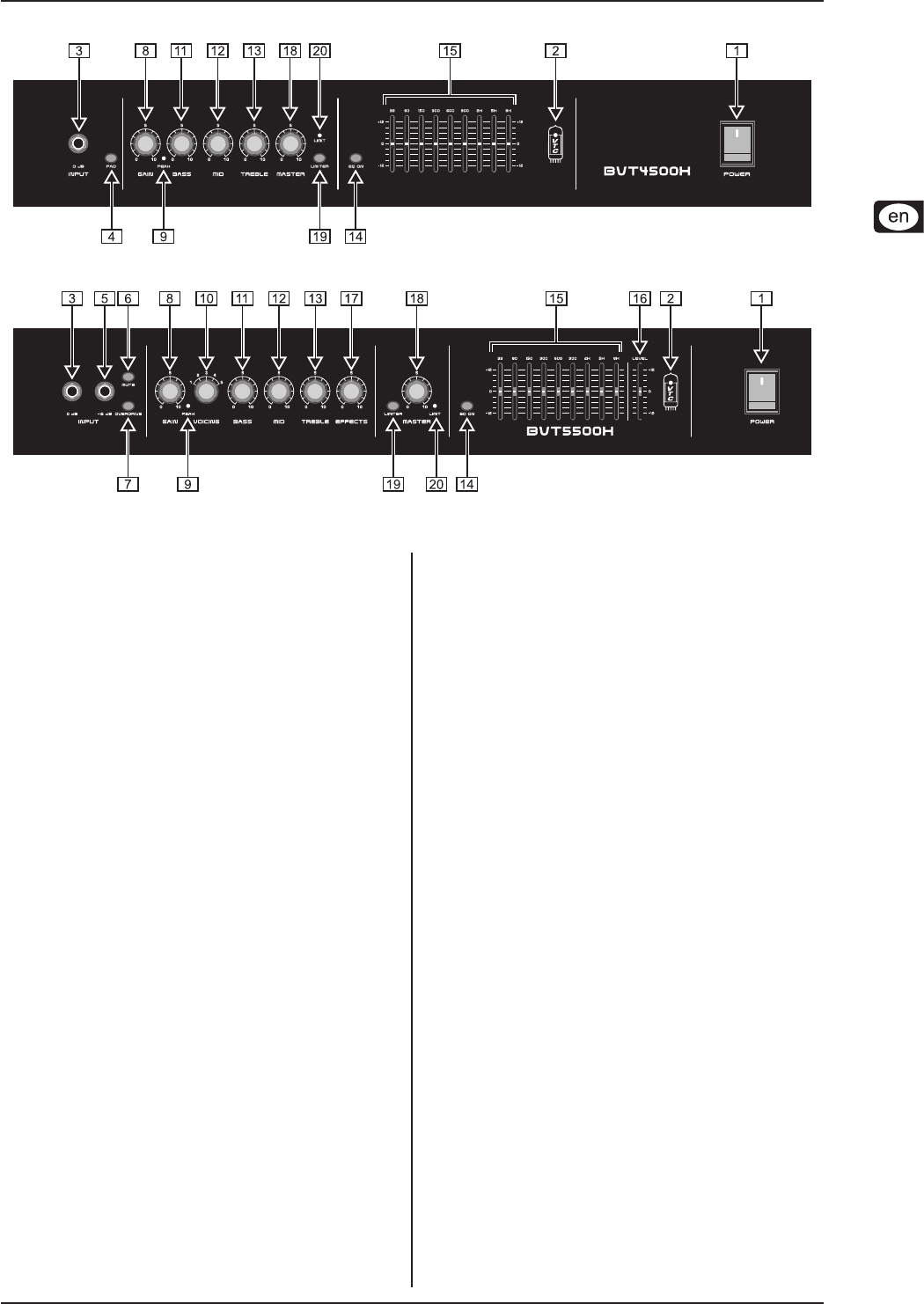
ULTRABASS BVT4500H/BVT5500H
Front panel 5
Front panel2.
BVT4500H front panelFig. 2.1:
BVT5500H front panelFig. 2.2:
This section describes how to use the front panel of the BVT4500H
and the BVT5500H, illustrated on the previous page and above.
{1} POWER switch: Use the POWER switch to turn on your
BVT4500H/5500H. The POWER switch should always be
in the “Off” position when you are about to connect your unit
to the wall socket or disconnect it.
Switch-on thumps can damage your hearing and your +
speakers. Before you connect the BVT to the mains,
ensure that it is turned off.
{2} VTC LED: When the BVT is off, this LED is not illuminated.
When it is on, this LED is illuminated and indicates that the
amp is activated for use. VTC is BEHRINGER’s analog tech-
nology that emulates the warmth of vintage tube circuitry.
INPUT features
To input an audio signal to the BVT, use features {3} - {7}, as
follows:
{3} 0 dB jack: To connect an electric bass to the BVT, use this ¼"
mono jack (unbalanced). Basses with active pickups create
high-level signals.
If your bass includes an active pickup and you work with:
the BVT4500H, use the = PAD button {4} to reduce the input
audio signal.
the BVT5500H, use the = -15 dB jack {5}instead of the 0 dB
jack.
{4} PAD button (BVT4500H only): If the PEAK LED {9} con-
stantly illuminates and the GAIN control {8} is set to 0 (zero),
the input level of the audio signal is too high. In this case,
press this button to activate the pad. The pad reduces the
input sensitivity by 15 dB.
{5} -15 dB jack (BVT5500H only): To connect an active bass to
the BVT5500H, use this ¼" mono jack (unbalanced). Using
this jack will give you a lower input sensitivity as compared
with the 0 dB jack.
{6} MUTE button (BVT5500H only): Use this button if you want
to tune a bass without hearing the tone. This feature mutes
the main signal path, but not the TUNER output.
{7} OVERDRIVE button (BVT5500H only): Use this button to
add a distorted texture to the audio signal. This feature
“overdrives” the BVT5500H preamp.
{8} GAIN control: Use this control to boost or cut the level of the
input signal.
{9} PEAK LED: At various points in the signal path, the BVT
monitors the level of the audio signal. When the level is too
high, the PEAK LED warns that clipping can occur.
If the LED:
occasionally illuminates, the BVT clips only some peaks in the =
audio signal. Occasional clipping does not reduce the sound
quality and shows that the signal is strong enough.
never illuminates, the BVT does not clip any signal peaks in =
the audio signal. The audio signal is probably too weak to
make use of the full dynamic range. Increase the GAIN {8}
setting until the PEAK LED lights up only occasionally, at the
strongest signal peaks.
constantly illuminates, the BVT clips a large part of the audio =
signal and you will hear a distortion. Lower the GAIN setting
and check for extreme fader or control settings.
TONE features
“Tone” refers to the presence and quality of these frequency bands
of an audio signal:
bass: from 30 to 200 Hz =
mid-range: from 200 to 2 000 Hz =
treble: from 2 000 Hz to 20 kHz =
The BVT offers controls to effectively tailor the sounds to your
needs by cutting or boosting specic bands. To adjust the tone,
use features (10) - (13), as follows:
(10) VOICING control (BVT5500H only): To select the tone you
want, turn this knob to one of the following presets.
The BVT5500H equalizes the audio signal for you.
1: Prominent bass and treble tones (scooped mids). =
2: Smooth and warm treble tones (passive tone). =
3: Flat, natural bass tones (no equalization). =
4: Bright treble tones. =
5: Flat, natural bass tones that are not muddy (bass rolloff). =
(11) - (13) BASS, MID, and TREBLE controls: For each tone
(bass, mid-range, and treble) that you can emphasize or
de-emphasize, the BVT includes a single TONE control.














